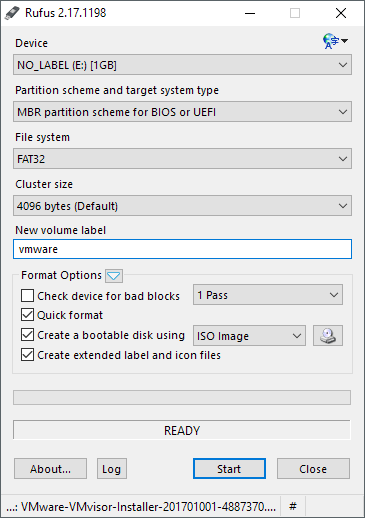
- #Vmware esxi iso to usb how to#
- #Vmware esxi iso to usb install#
- #Vmware esxi iso to usb upgrade#
- #Vmware esxi iso to usb software#
- #Vmware esxi iso to usb download#
Only other thing connected to the physical server is my 8gb USB drive with the ESXi 5.5 installation. Don't want to mess anything up with the running system.Īnd just for clarification: My server runs a Raid-5 (6 HDDs) and all of my Data is located on this raid.

#Vmware esxi iso to usb upgrade#
Do you mean upgrade in the following sense: shutdown physical server machine with the VMWare usb stick, THEN put the 6.0 ISO Image on a DVD and boot at the physical server machine, THEN let it do an upgrade on my original 5.5 usb drive? If so, I will consider this as soon as I have a working duplicate of my usb drive. But thanks for the advice, I will get said tool and check it out.ģ. But with every cloned USB drive I was unable to boot so I gave that up for the time being. I tried with a CloneZilla Boot CD, which is pretty much a guided "dd" or something like that. Thank you for your help, it is very appreciatedġ.
#Vmware esxi iso to usb install#
#Vmware esxi iso to usb how to#
I’ll be writing another article soon on how to install ESXi onto a Dell PowerEdge server soon.I was given the task to be admin for our server, currently running ESXi 5.5 System Update 2 with 4 virtual machines. You can now boot your server from the flash drive to begin the install process. That’s about it! Rufus will now create bootable flash media for the ESXi installer. If you get the message, go ahead and click Yes to update to the newest version of the menu file. You may get a message that the ISO image is using an obsolete version of menu.c32 and that the boot menus may not display properly. At the bottom, it’ll say Ready and you can click on the Start button to begin the process. Click on the small disc icon to the right of the dropdown and select the ESXi ISO image you downloaded. Next, click on the dropdown next to Create a bootable disk using and choose ISO image.

Change that to something short without spaces or special characters. Leave everything else with the default settings except the volume label. In my case, I used a small 1 GB flash drive as that was enough for the ESXi installer. You can just delete it after you are done using it.Īt the top, click on Device and choose your USB drive. What I like about Rufus is that it’s a standalone program that doesn’t require any kind of installation.

When you have the ISO image downloaded, go ahead and run Rufus.

#Vmware esxi iso to usb download#
That link is for version 6.5, so if a newer version is out, make sure to download that instead. Once you have downloaded Rufus, go ahead and download the VMware ESXi installer. However, I found Rufus to be the fastest out of all the programs. If you already have a program like Windows USB/DVD Download Tool or RMprep, feel free to use those. Rufus basically lets you take ISO image files and create bootable flash media.
#Vmware esxi iso to usb software#
In this article, I’ll show you how to create a bootable ESXi installer using a USB flash drive and a free software program called Rufus. The last way, and the easiest in my opinion, is to simply use a USB flash drive. There are several ways you can go about installing ESXi onto your server: remotely using iDRAC if you have that setup on a Dell server, using the SD card slot or via the CD/DVD ROM drive. I recently purchased a refurbished Dell PowerEdge server for my home lab and decided to go ahead and install VMware ESXi (vSphere Hypervisor) so that I could play around with different virtual machines.


 0 kommentar(er)
0 kommentar(er)
